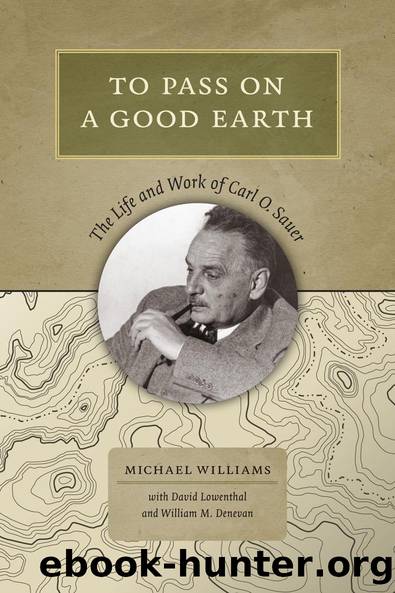To Pass On a Good Earth by unknow

Author:unknow
Language: eng
Format: epub
Tags: Nonfiction, Social & Cultural Studies, Social Science, Human Geography
ISBN: 9780813935775
Publisher: University of Virginia Press
Published: 2014-06-24T04:00:00+00:00
The First Americans
Sauerâs work on the Handbook made him ponder how so many plants had been domesticated. Genetics provided important evidence, but he could not personally contribute to knowledge in that field. For primitive humans to have brought about such great changes in the continentâs biota required more time, he believed, than archaeologists were prepared to allot. Hence the âcalendar of manâs record in the New World must be lengthened.â24
âA Geographic Sketch of Early Man in Americaâ reached Gladys Wrigley, editor of the Geographical Review, in May 1944 and was quickly published in October.25 Wrigley was delighted. It was âa feastâ for readers. Sauer, gratified by her reaction, mentioned that he probably had another couple of articles on early man and plants in the pipeline. âIs there a book in it for the Research Series of the [American Geographical] Society?â she asked.26 The âGreat Leviathan,â as Wrigley termed the article, was a tightly argued survey of the entry and dispersal of early humans into both Americas, along with hypotheses about plant distributions and their alteration by humans.
Sauer first reviewed the glacial history of the Americas. He accepted the conventional explanation that lower sea levels had allowed humans from northeast Asia (Berengia) to cross a wide land bridge over what is now the Bering Straits into Alaska and to migrate south via a corridor between the receding ice sheets. What he was not prepared to concede was the late conventional date of that migration at around 10,000 BP, held then by most archaeologists.27
Folsom and Yuma man (the earliest known humans in the Americas up to about 1949 when Clovis man was discovered)28 must have been present, he suggested provocatively, for âat least twenty to twenty-five thousand years.â The presence of âPleistocene manâ (i.e., Ice Age man) âcan no longer be denied, it is only a question of how far back his title extends in America.â29
Neither climate change nor disease could account for the total extinction of the large Pleistocene megafauna â mammoths, giant bison, musk ox, giant elk, and giant bear â in the space of a mere few hundred years. Their demise could have been due only to the hunting skills of early humans, who used fire to drive the herds and whose âastonishing perfection of lithic techniquesâ produced the deadliest of spear heads, equal in quality to those of the Solutrean cultures of France and Spain between 16,500 and 25,000 BP.
Sauer believed that pervasive and destructive fires had facilitated the formation and expansion of the American grasslands. This was not a climatically induced climax vegetation, as was commonly assumed, but rather a biotic transformation that needed over 20,000 years of human use of fire and animal grazing to produce the vast present-day prairies and pampas.30 He then turned to the routes of dispersal across the continents.
Sauer was pleased with the impact of the article, which brought him into the center of national scholarly discourse. The âsteady trickleâ of letters from biologists and natural scientists turned into a regular stream.
Download
This site does not store any files on its server. We only index and link to content provided by other sites. Please contact the content providers to delete copyright contents if any and email us, we'll remove relevant links or contents immediately.
Harry Potter and the Goblet Of Fire by J.K. Rowling(3043)
Unfinished: A Memoir by Priyanka Chopra Jonas(2916)
Never by Ken Follett(2880)
The Man Who Died Twice by Richard Osman(2298)
Machine Learning at Scale with H2O by Gregory Keys | David Whiting(2290)
Fairy Tale by Stephen King(2069)
Will by Will Smith(2041)
Rationality by Steven Pinker(1765)
The Storyteller by Dave Grohl(1660)
The Dawn of Everything: A New History of Humanity by David Graeber & David Wengrow(1570)
The Dark Hours by Michael Connelly(1569)
The Stranger in the Lifeboat by Mitch Albom(1532)
Cloud Cuckoo Land by Anthony Doerr(1434)
The Becoming by Nora Roberts(1330)
Friends, Lovers, and the Big Terrible Thing by Matthew Perry(1327)
New Morning Mercies: A Daily Gospel Devotional by Paul David Tripp(1321)
Einstein: His Life and Universe by Walter Isaacson(1315)
Crying in H Mart by Michelle Zauner(1315)
A Short History of War by Jeremy Black(1300)
